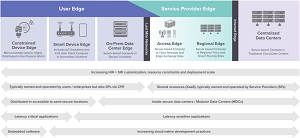News
'State of the Edge 2021' Report Predicts Big Growth Driven by Open Source
The "State of the Edge 2021" report from umbrella organization LF Edge predicts huge growth for edge computing, driven by open source initiatives -- and, in some cases, COVID-19.
LF Edge, under The Linux Foundation, is known for establishing an open, interoperable framework for edge that is independent of hardware, silicon, cloud platform or operating system.
As with most things today, the coronavirus pandemic figures into the report.
"Our 2021 analysis shows demand for edge infrastructure accelerating in a post COVID-19 world," said Matt Trifiro, co-chair of State of the Edge and CMO of edge infrastructure company Vapor IO, in a news release last month. "We've been observing this trend unfold in real-time as companies re-prioritize their digital transformation efforts to account for a more distributed workforce and a heightened need for automation. The new digital norms created in response to the pandemic will be permanent. This will intensify the deployment of new technologies like wireless 5G and autonomous vehicles, but will also impact nearly every sector of the economy, from industrial manufacturing to healthcare."
 [Click on image for larger view.] The Edge Continuum (source: LF Edge).
[Click on image for larger view.] The Edge Continuum (source: LF Edge).
The report indicates the deployment of new edge infrastructure and applications continued in 2020 despite the impact of COVID-19. In fact, it says some deployments were driven by the pandemic, part of a pattern of COVID-19 accelerating digital transformation and service adoption. Seven out of 10 areas studied in the report saw increased forecasts compared to last year's report, with a number of new use cases being driven by 5G.
In total, the report predicts that cumulative capital expenditures of up to $800 billion USD will be spent on new and replacement IT server equipment and edge computing facilities between 2019 and 2028, split evenly between equipment for the device and infrastructure edges.
The entire 95-page PDF report, available here, is summarized by these "important findings" as listed by LF Edge:
- COVID-19 highlighted that expertise in legacy data centers could be obsolete in the next few years as the pandemic forced the development of new tools enabled by edge computing for remote monitoring, provisioning, repair and management.
- Open source hardware and software projects are driving innovation at the edge by accelerating the adoption and deployment of applications for cloud-native, containerized and distributed applications.
- The LF Edge taxonomy, which offers terminology standardization with a balanced view of the edge landscape, is based on inherent technical and logistical tradeoffs spanning the edge to cloud continuum is gaining widespread industry adoption.
- Off-the-shelf services and applications are emerging that accelerate and de-risk the rapid deployment of edge in these segments. The variety of emerging use cases is in turn driving a diversity in edge-focused processor platforms, which now include Arm-based solutions, SmartNICs with FPGA-based workload acceleration and GPUs.
- Edge facilities will also create new types of interconnection. Similar to how data centers became meeting points for networks, the micro data centers at wireless towers and cable headends that will power edge computing often sit at the crossroads of terrestrial connectivity paths. These locations will become centers of gravity for local interconnection and edge exchange, creating new and newly efficient paths for data.
- 5G, next-generation SD-WAN and SASE have been standardized. They are well suited to address the multitude of edge computing use cases that are being adopted and are contemplated for the future. As digital services proliferate and drive demand for edge computing, the diversity of network performance requirements will continue to increase.
While no specific methodology for the report was listed, the organization said: "This 2021 State of the Edge report explores today's edge computing ecosystem with a focus on the increasingly interconnected domains of critical infrastructure, networks, software, and hardware. In line with previous reports, the insights are provided by independent experts with the goal of educating and advancing the field. The report also builds upon previous editions with updated market sizing data, as well as thoughts from industry leaders."
About the Author
David Ramel is an editor and writer at Converge 360.